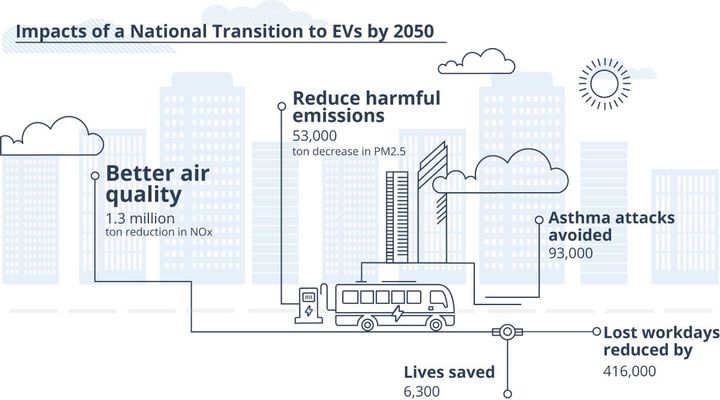Graphic: AMPLY Power
The environmental benefits of these efforts can fortify the economic benefits, where each fleet transition can substantially reduce carbon into the atmosphere. For each 15-vehicle fleet that transitions to electrification, AMPLY has uncovered that as many as two million kilograms of CO2 emissions can be avoided.
Government agencies, school districts, and private fleet operators alike are all seeking solutions to save on fuel costs while reducing greenhouse gas emissions.
AMPLY Power, a provider of charge management services and software for fleets, on Aug. 3 released its 2021 white paper, Managed Charging Accelerates Cost and Health Benefits of EVs, assessing the cost saving potential of transitioning to an electric vehicle (EV) fleet in the top 25 U.S. metro areas.
The white paper also examines the correlation between the effects of local pollution from fossil fuel fleets and the economics of transitioning to zero emission fleets, with the potential of avoiding $72 billion in adverse health effects, according to a news release summarizing the white paper.
The white paper uses AMPLY’s proprietary dollar per gallon-equivalent (DPGe) metric, which is the dollars needed to drive an EV the same number of miles compared to an internal combustion engine (ICE) vehicle, expressed in a per gallon basis and adjusted for city-specific electricity rates structures and vehicle efficiencies.
In all of the top 25 metro areas, a charge management system (CMS) can offer EV fleets savings of up to 83% compared to diesel and unmanaged electric fleet charging operations. AMPLY developed an interactive DPGe map which directly compares these different fueling types.
“In order to give a more complete picture of the costs involved for fleets considering the transition to electric, we expanded our study this year to include community health and medical expense impacts,” said Vic Shao, CEO and founder of AMPLY Power, in the news release. “The findings and implications of this assessment should influence how fleet managers, electric utilities, policymakers, and regulators think about electric vehicle fleets in their businesses, states, or regions.”
The environmental benefits of these efforts can fortify the economic benefits, where each fleet transition can substantially reduce carbon into the atmosphere. For each 15-vehicle fleet that is electrified, AMPLY has uncovered that up to two million kilograms of CO2 emissions can be avoided.
Widespread electrification has positive health impacts on frontline communities. As an example, working with data from The Journal of Allergy and Clinical Immunology, AMPLY’s analysis indicates an economic impact of $.01 per vehicle mile travelled (VMT) in the cost of treating children affected by traffic-related asthma for Los Angeles County. Further, the white paper points out that a national transition to electric vehicles could produce emission reductions by 2050 that equate to $72 billion in avoided health effects, which can be attributed to a 1.3 million ton decrease in NOx and a 53,000 ton decrease in PM2.5.
“Our DPGe results show there is real economic value to electrifying vehicle fleets, but that value must be understood in locational- and operational-specific terms,” Shao said. “Because there is still variability due to utility rate structures and peak charging windows, fleets need to consider a managed charging approach so that energy and electric fleet operating costs can be significantly reduced.”
AMPLY Power supports fleets as they consider switching to electric vehicles. Recently, AMPLY unveiled its initiative to transition all California customers, including Tri Delta Transit, Solano County Transit, Palermo Union School District and Anaheim Transportation Network, to 100% renewable energy. Additionally, AMPLY partnered with Duke Energy earlier this year to assist in delivering clean electricity for customers using a patent-pending solar canopy mount. In 2021 alone, the company has made strides toward promoting the adoption of fleet electrification with their partnerships with UES, U.S. Gain, BYD, and CPower.
Originally posted on Charged Fleet
Source: https://www.automotive-fleet.com




